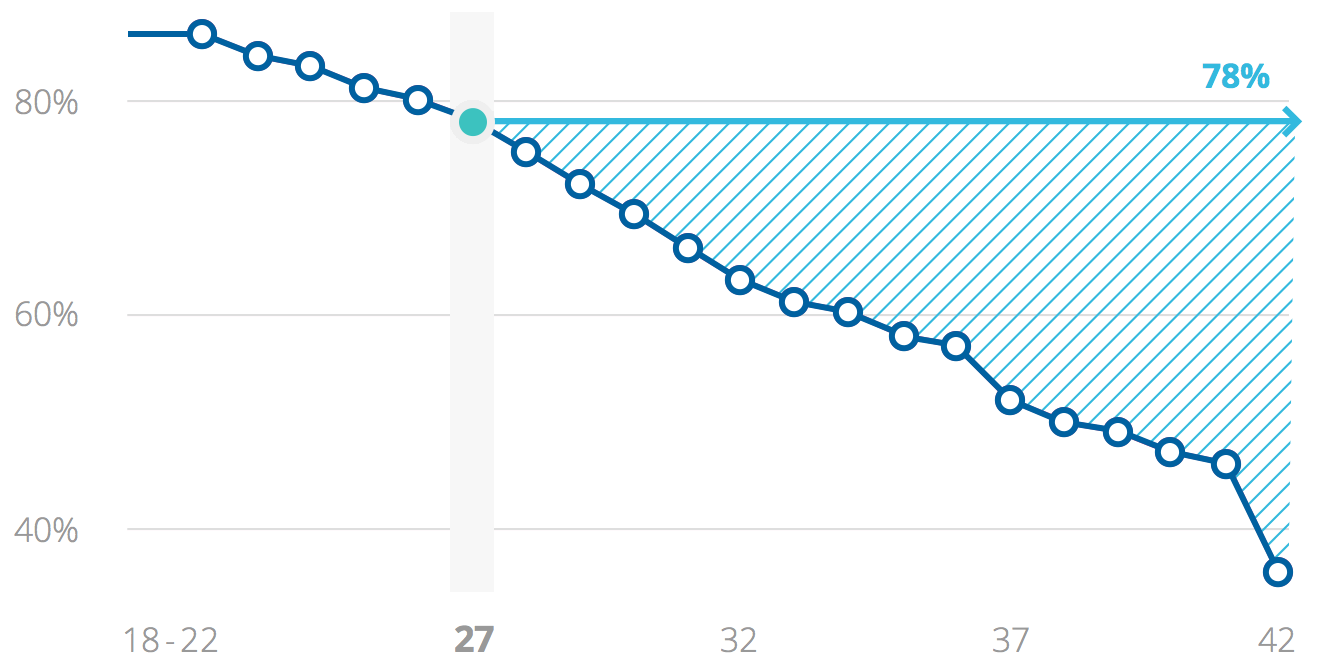Fertility preservation
Egg freezing, or oocyte vitrification, is the process used for
preserving a woman’s fertility.
Egg freezing, or oocyte vitrification, is the process used for preserving a woman’s fertility.
Timefreeze Fertility Calculator
From the age of 35 onwards, one in six women who decide to have children will encounter some kind of difficulty in achieving it.
From the age of 35 onwards, one in six women who decide to have children will encounter some kind of difficulty in achieving it.
What is your chance of getting pregnant?
Age
Without egg freezing
With egg freezing

Recommended age limit: 40
Chance of pregnancy
Recommended age limit: 40
When is fertility preservation recommended?
With egg vitrification, mature eggs are preserved by the ultra-rapid freezing method until the time you decide to become a mother.
For social reasons
If it is clear to you that you want to become a mother in the future, but you feel that it isn’t the right time to have children, either because you don’t have a partner or for other personal reasons.
For medical reasons
Whether for oncological reasons or due to autoimmune diseases you are going to start chemotherapy or radiotherapy sessions, which are very aggressive treatments for your fertility, or if you need gynaecological surgery due to other diseases (endometriosis, ovarian cysts…), then preservation is seen as an option for the future when you wish to become a mother.
With oocyte vitrification, you can postpone the decision to become a mother with your own eggs and rest assured that, when the time comes, should you need to resort to an assisted reproduction technique, you would have the same chances of becoming pregnant as you have right now.
How do we do things at Eugin?
You will have a team of professionals at all times to put your mind at ease. They will share your hopes and
help you to fulfil your dream of becoming a mother when the time comes.
You will have a team of professionals at all times to put your mind at ease. They will share your hopes and help you to fulfil your dream of becoming a mother when the time comes.
We use state-of-the-art technology backed by science and carried out by a team of high-level specialists.
We have brought 20,000 babies into the world in 25 years. We are a European benchmark.
We personalise the treatment and monitoring of your medical and personal needs. We are there for you 24 hours a day.
Advantages of egg freezing
The vitrification technique allows you to preserve all the genetic characteristics of your eggs for an indefinite period of time until
the moment you decide to become a mother.
Advantages of egg freezing
The vitrification technique allows you to preserve all the genetic characteristics of your eggs for an indefinite period of time until the moment you decide to become a mother.

Quick process
In a fortnight and with just two
trips to the clinic.

Your eggs
If needed, you will be able
to use your own eggs tomorrow.

Peace of mind
Your eggs will retain the same
quality they have when you
undergo treatment.

Best rates
Vitrification is the technique
with the best egg survival rates
after thawing.
How does the process work?

First visit
Before you can begin with the preparation of your ovaries (ovarian stimulation), you will attend a visit with our medical team, who will assess your medical history together with the tests you bring with you or have undergone at the clinic, while giving you the necessary advice and answering any queries you may have.

Stimulation
When your period comes, you will start the stimulation, which will last approximately 10 days, and you will administer the medication yourself. You will see that it is very simple and totally compatible with your daily routine.
While your ovaries are being prepared, we will carry out ultrasound checks on your follicle development (follicular checks), which are located in your ovaries, every 2 or 3 days at the clinic or with your gynaecologist, depending on what suits you best.

Oocyte retrieval
When your ovaries are ready, we will schedule the day to retrieve your eggs. On that day, you will stay at the clinic for approximately two hours, during which time we will then aspirate the eggs.
This is when your treatment ends and the laboratory procedure starts, which is where the vitrification process (ultra-rapid freezing) of your eggs at -196ºC with liquid nitrogen will take place.
From that moment on, your eggs will be safe for when you need them. When you leave the clinic, you will be able to lead a normal life.
How is an egg frozen?
The youtuber and science broadcaster “La Hiperactina” explains what the egg vitrification technique is all about in order to preserve fertility.
The youtuber and science broadcaster “La Hiperactina” explains what the egg vitrification technique
is all about in order to preserve fertility.
The egg freezing technique: a step-by-step guide
Vitrification is the technique we use to preserve a woman’s mature eggs. The method we use consists
of ultra-rapid freezing in which we submerge the eggs in liquid nitrogen at -196ºC so that we avoid
the formation of crystals as the freezing speed is so fast, thus allowing a higher survival
rate of the eggs for the day we need them. With this method, these cells remain unaltered until the moment
they are to be used.
Step 1
Puncture
After ovarian stimulation, the oocytes are retrieved from the ovary by puncturing. It is a quick procedure.
Step 2
Oocyte selection
Next, in the laboratory, the mature oocytes are selected and those that have not reached a sufficient degree of maturity are discarded as they are not suitable for fertilisation.
Step 3
Oocyte cleaning
One by one they are dipped in a sucrose solution, which removes the water they contain in order to avoid the formation of crystals during freezing, which could damage them.
Step 4
Insertion in straws
Finally, the oocytes are placed in a small tube called a straw, which is prepared for the cryopreservation. A straw is a storage medium in which the cells or embryos are placed and can be frozen as a group or individually.
Step 5
Cryonization
The straws are immersed in liquid nitrogen at a temperature of -196ºC, and within seconds they are frozen without ice forming.
Step 6
Preservation
Once frozen, the eggs will be kept unaltered and properly identified according to the patient’s name and identifying code in the nitrogen tank for an indefinite period of time, until it is time to use them.
Step 7
Your photo souvenir
At the end of the egg freezing process, the patient receives, as a memento, a digital photograph with a picture of the oocytes that have been vitrified.
Step 8
Eventual thawing
To thaw the eggs, the process is reversed.
The egg freezing technique: a step-by-step guide
Vitrification is the technique we use to preserve a woman’s mature eggs. The method we use consists of ultra-rapid freezing in which we submerge the eggs in liquid nitrogen at -196ºC so that we avoid the formation of crystals as the freezing speed is so fast, thus allowing a higher survival rate of the eggs for the day we need them. With this method, these cells remain unaltered until the moment they are to be used.
Step 1
Puncture
After ovarian stimulation, the oocytes are retrieved from the ovary by puncturing. It is a quick procedure.
Step 2
Oocyte selection
Next, in the laboratory, the mature oocytes are selected and those that have not reached a sufficient degree of maturity are discarded as they are not suitable for fertilisation.
Step 3
Oocyte cleaning
One by one they are dipped in a sucrose solution, which removes the water they contain in order to avoid the formation of crystals during freezing, which could damage them.
Step 4
Insertion in straws
Finally, the oocytes are placed in a small tube called a straw, which is prepared for the cryopreservation. A straw is a storage medium in which the cells or embryos are placed and can be frozen as a group or individually.
Step 5
Cryonization
The straws are immersed in liquid nitrogen at a temperature of -196ºC, and within seconds they are frozen without ice forming.
Step 6
Preservation
Once frozen, the eggs will be kept unaltered and properly identified according to the patient’s name and identifying code in the nitrogen tank for an indefinite period of time, until it is time to use them.
Step 7
Your photo souvenir
At the end of the egg freezing process, the patient receives, as a memento, a digital photograph with a picture of the oocytes that have been vitrified.
Step 8
Eventual thawing
To thaw the eggs, the process is reversed.
Why choose Timefreeze?
Timefreeze is the egg vitrification programme of the Eugin medical group, a world leader and specialist in fertility and assisted reproduction.
24/7
By your side. From the first
step you take to the last,
we will be by your side for
whatever you need.
25 years’
experience in the sector.
8.000
treatments a year.
35
clinics
10 countries and 2 continents.
1.500
high-level specialists
of international repute.
State-of-the-art technology
We only apply state-of-the-art
techniques and technology,
which are always backed by
science, in the pursuit of maximum
safety.
Why choose Timefreeze?
Timefreeze is the egg vitrification programme of the Eugin medical group, a world leader and specialist in fertility and assisted reproduction.
24/7
By your side. From the first
step you take to the last,
we will be by your side for
whatever you need.
25 years’
experience in the sector.
8.000
treatments a year.
35
clinics
10 countries and 2 continents.
1.500
high-level specialists
of international repute.
State-of-the-art technology
We only apply state-of-the-art
techniques and technology,
which are always backed by
science, in the pursuit of maximum
safety.
Prices
The study phase, ovarian stimulation treatment follow-up, follicular aspiration (egg retrieval), vitrification, and egg storage for 4 years are included. Contact us and our team will help you to fulfil all your needs.
Frequently asked questions about treatment
You can also contact our team.
A healthy woman has an ovarian reserve of about 400,000 eggs.
From your first period on, your eggs mature at a rate of one every 28 days. In an egg freezing treatment, only a few eggs are removed. It is perfectly possible to get pregnant naturally after freezing a few of your eggs. This treatment neither advances nor delays the menopause.
The oocyte vitrification process has no known negative effects on the ovary, nor does it advance the menopause or cause weight gain. It has no effect whatsoever on your future fertility.
The process is generally well tolerated and only very exceptionally (in less than 0.35% of cases) may it involve health risks such as ovarian hyper-stimulation, which is an over-response to stimulation treatment, genital infection (incidence 0.01% to 1%), bleeding, ovarian torsion or perforations in loops of bowel, bladder or other parts of the anatomy and those associated with sedation.
You will receive full and detailed information from the medical team on all of this. It is not true that oocyte vitrification leads to effects such as weight gain or the sudden appearance of acne or body hair. It is true that during the process you will temporarily experience a slight increase in body volume due to fluid retention caused by the medications administered during ovarian stimulation. The medications have hormones that will cause the ovaries to swell and produce many more eggs, similar to the feeling of bloating that occurs just before and during menstruation. These symptoms are absolutely normal and temporary, beginning a few days after starting the hormone treatment and ending a few days after the oocytes are retrieved.
As far as the procedure for obtaining the eggs by follicular puncture is concerned, it is a minor surgical intervention of about 15-20 minutes, which we have a lot of experience in.
Rest is recommended on the day of the puncture, and you can resume normal daily activity the day after the puncture.
Don’t worry, there is no contraindication to starting stimulation if you are taking contraceptives. If you have an IUD, it will not be incompatible with freezing your eggs. If you have a hormonal IUD, your gynaecologist will explain the different options to you.
During this process, our biologists will take a photograph of your oocytes, which will be delivered to you.
We currently recommend oocyte vitrification for women up to the age of 40 who wish to defer childbearing for personal or professional reasons, and thus avoid the effects of age on fertility.
Egg freezing is a safe procedure that does not affect the quality of the egg: it has been proven that vitrified eggs are just as likely to produce a pregnancy as fresh eggs.
An egg’s vitrification process is so fast that it all happens in less than a second. The eggs go from their usual temperature of 37 degrees Celsius to minus 196 degrees Celsius. This change occurs at such a speed that the water surrounding the egg does not have time to freeze, but is left in a very hard glass-like state. In this way, the egg remains unaltered, without being damaged at any time.
The eggs, once vitrified, can be preserved for the woman’s entire fertile life, as indicated by the law.
In the event that they are not used, you can cede them for donation for reproductive purposes or for research purposes, or request the cessation of their preservation if you meet the appropriate criteria. In any case, you will choose the final use for your eggs, as long as this is within the legal framework established by Spanish law.
In order to get pregnant using your vitrified eggs, when the day comes, we will have to devitrify, fertilise, incubate and implant them. From that moment on, your pregnancy will be like that of any other woman.
With the current scientific evidence, we can say that the health of children born thanks to the application of assisted reproduction techniques, including oocyte vitrification, is equivalent to that of children conceived naturally.
Testimonials
Find out about the experiences of women who decided to delay motherhood.
“After having completed the treatment I am much calmer. I don’t feel so anxious about ageing because I know that I have a higher chance of becoming a mother in the future.”
“I saw that I was getting older and I couldn’t find the right person or a job that would give me complete stability. But when I decided to freeze my eggs, that stress disappeared.”
“I saw that I was getting older and I couldn’t find the right person or a job that would give me complete stability. But when I decided to freeze my eggs, that stress disappeared.”
“After having completed the treatment I am much calmer. I don’t feel so anxious about ageing because I know that I have a higher chance of becoming a mother in the future.”
“Testimonials based on feedback from real Eugin patients”
Do you still have any doubts?
You can ask our experts and under no obligation.
Do you still have any doubts?
You can ask our experts and under no obligation.
